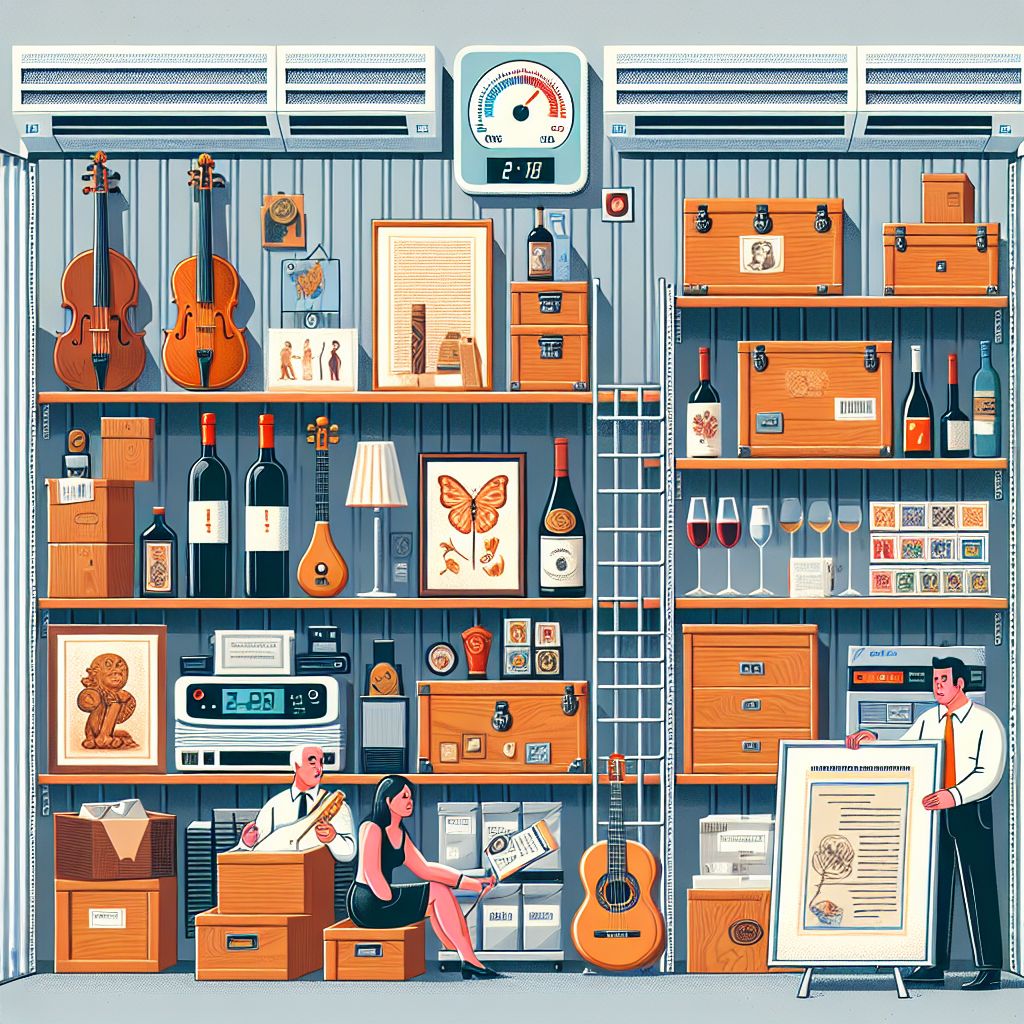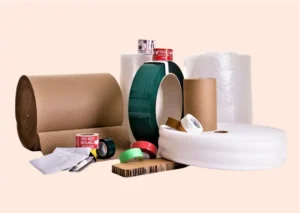Table of Contents
- 1 What is Climate-Controlled Storage?
- 2 Do You Really Need Climate-Controlled Furniture Storage?
- 3 Figuring Out Which Furniture Requires Climate Control
- 4 Climate-Controlled Storage vs. Regular Storage
- 5 When Should You Think About Using Climate-Controlled Storage?
- 6 Choosing the Best Storage Option
- 7 Frequently Asked Questions: We’ve Got the Answers
- 8 Author

Important Points
-
Climate-controlled storage is designed to maintain specific temperature and humidity levels to protect sensitive items.
-
Extreme temperatures and fluctuating humidity can cause irreversible damage to furniture.
-
Wood, leather, and upholstered furniture can benefit significantly from climate-controlled environments.
-
While climate-controlled storage may be more costly upfront, it can save money in the long term by preserving valuable furniture.
-
Reaching out to a reputable storage provider can ensure your furniture is protected in the appropriate climate conditions.
What is Climate-Controlled Storage?
Climate-controlled storage refers to a space that’s designed to keep your belongings, particularly furniture, at a consistent temperature and humidity level. This type of storage is essential if you’re storing items that are sensitive to the environment—like your grandmother’s oak armoire or your chic leather sofa.
Climate-controlled storage is like a comfy home for your furniture, keeping it safe from the blazing heat of summer and the freezing cold of winter. But it’s not just about temperature; it’s also about maintaining the perfect air conditions, so your valuable items don’t dry out, warp, or become a haven for mold and mildew.
Understanding the Term “Climate-Controlled”
It’s important to know what we’re talking about when we say ‘climate-controlled.’ This term means that the storage unit has the ability to keep the temperature between 55°F and 85°F. But, what’s really crucial is that it can control humidity levels. Humidity is a major cause of damage to furniture. The air in these units is also circulated continuously, helping to keep your items dry and prevent them from smelling musty.
Why is Temperature Important for Your Furniture?
What does this mean for your furniture? The cold can cause wood to shrink and crack, while the heat can cause it to swell and warp. Leather is also affected by the weather, as it can dry out and crack when the conditions are not optimal. Upholstery is not safe either; it can fade and deteriorate in harsh conditions.
Do You Really Need Climate-Controlled Furniture Storage?
You might be thinking, “I’ve stored my furniture in the garage for years without any problems.” While that might be the case, when you’re storing furniture for a longer period of time, or if you live in a place with extreme weather conditions, you’re taking a risk. It’s not just about keeping your furniture looking good; it’s also about making sure it stays strong and structurally sound.
Dangers of Storing Furniture without Climate Control
When you don’t have climate control, your furniture is exposed to the elements. Wood can break and split, leather can lose its color and become hard, and fabrics can lose their color and get moldy. In short, you risk turning your precious items into musty versions of what they used to be.
It’s not just the immediate damage you need to worry about. These conditions can slowly deteriorate your furniture, leading to expensive repairs or replacements. That’s why choosing climate-controlled storage is a wise decision—it’s like having insurance for the lifespan of your furniture.

Various materials respond to temperature and humidity changes in different ways. For more insights, here’s a brief overview:
-
Wood: It expands in humid conditions, contracts in dry conditions, and can crack or warp if the changes are extreme.
-
Leather: Requires a stable environment to prevent it from drying out, fading, or cracking.
-
Upholstery: It can develop mold or mildew in high humidity, and dry air can make fabrics brittle.
As a result, understanding the materials of your furniture is critical when thinking about storage options.
Figuring Out Which Furniture Requires Climate Control
Having covered the fundamentals, we can now delve into the details. Not all furniture requires climate-controlled storage. Some items can be stored in standard conditions, while others really need that extra layer of protection. To understand better, you can read about items that require climate-controlled storage and make an informed decision.
Wooden Furniture
Wood, being a natural material, is alive and responds to its surroundings. If the environment is too dry, wood can crack or split. If it’s too damp, it can expand and distort. Climate-controlled storage maintains the humidity and temperature at levels that prevent this type of damage, keeping your wooden furniture in the best possible condition.
Leather Furniture
Leather furniture is similar to human skin—it requires moisture to prevent dryness and cracking. However, excessive moisture is also harmful as it can cause mold and mildew. Climate-controlled storage provides the ideal conditions, ensuring your leather sofas and chairs remain as luxurious as the day you purchased them.
Furniture with Upholstery and Fabric
Your comfy couch and recliners can fade and break down in severe conditions. Climate control safeguards the fabric’s color and structure, ensuring you can relax in comfort for many more years.
Climate-Controlled Storage vs. Regular Storage
Knowing the difference between climate-controlled storage and regular storage is crucial to make the best decision for your furniture. Regular storage might be fine for short-term storage or for items that aren’t sensitive to temperature or humidity. But for your valuable furniture pieces? It’s a risk.
Is It Worth the Extra Cost?
Climate-controlled storage does cost more than standard storage. However, you should look at it as an investment in the lifespan of your furniture. Let me give you a simple comparison to make it clearer:
Consider you have an antique wooden dresser. In a standard unit, the fluctuating temperatures and humidity could cause the wood to crack, costing you hundreds in restoration. In a climate-controlled unit, your dresser remains untouched, preserving its value and saving you money in the long run.
Long-term Effects on Furniture Value
-
Climate control preserves antique furniture, maintaining its historical and monetary value.
-
Protects investment pieces, ensuring they continue to serve as functional decor.
-
Maintains the structural integrity of furniture, preventing costly repairs or replacements.
Therefore, if you’re storing furniture that has sentimental or financial value, climate control is a smart choice.
|
Aspect |
Climate-Controlled Storage |
Regular Storage |
|---|---|---|
|
Temperature |
Maintains consistent temperatures (55 to 85 degrees Fahrenheit) and stable humidity levels |
Susceptible to weather conditions like rain, heat, and humidity. |
|
Humidity Control |
Helps protect items from extreme temperature fluctuations that can damage sensitive items like wood furniture, electronics, and fine art. |
Lack of humidity control, which can lead to mold, mildew, and damage to items. |
|
Security |
Typically more secure with code-protected doors and limited access to specific floors. |
Less secure, as outdoor units are more exposed to potential risks. |
|
Accessibility |
May be less accessible due to the need to transport items through elevators, potentially limiting accessibility. |
More accessible, with easier access to items stored in outdoor units. |
|
Cost |
Generally costs more due to the added benefits of temperature control, humidity control, and increased security. |
Can be cheaper than climate-controlled storage units. |
|
Protection |
Offers protection against pests, dust, dirt, and outdoor elements, ensuring items are kept in a controlled environment. |
Susceptible to pests, dust, dirt, and weather conditions, potentially risking damage to stored items. |
|
Lighting |
Often well-lit with electricity available in some units, providing better visibility and convenience. |
Typically lacks lighting and electricity, making it harder to access items, especially at night. |

When Should You Think About Using Climate-Controlled Storage?
Choosing to use climate-controlled storage doesn’t need to be a difficult decision. Here are a few things to consider that can help you decide.
Assessing How Long You’ll Need Storage
For brief periods of storage, regular units might be enough. However, if you’re planning on storing your furniture for several months or even years, you should consider climate-controlled storage. The longer your furniture sits in storage, the higher the chances of it being damaged by the elements.
Taking into Account Seasonal and Locational Factors
The climate in your region is a significant factor in this choice. If you reside in a region with severe weather conditions or high humidity, climate-controlled storage isn’t just a suggestion; it’s a necessity to safeguard your possessions from the weather.
Furthermore, think about the time of year you’ll be storing your belongings. The heat of summer and the cold of winter can be especially damaging to furniture, so climate control is a good idea for storing items during the off-season.
Choosing the Best Storage Option
With all of this knowledge, you are now ready to choose the best storage option for your furniture. But if you’re still unsure, here are some questions to help you decide:
Questions to Consider
-
How much is the furniture worth (in terms of money or sentiment)?
-
How long do you intend to keep your items in storage?
-
What are the usual weather conditions in your region?
-
Can you afford the additional expense of climate control to safeguard your property?
These questions will help you better understand your storage requirements.
Investigating Your Storage Options
Now that you have the information you need, it’s time to look at what storage options are available to you. There are many choices out there, but not all storage facilities are the same. You want to find a facility that is not only secure, but also has the right conditions for your furniture.
Top Climate-Controlled Storage Choices
You can find a variety of trusted storage providers that have climate-controlled units. Some are big, well-known businesses, while others are smaller, local companies that may provide more tailored service. Regardless of which one you select, make sure they have good reviews and clear pricing.
Don’t forget, if you’re in need of the best climate-controlled storage to keep your furniture in perfect condition, feel free to Get in Touch. We’re always ready to assist you in finding the ideal storage solution for your valuable items.
Climate-Controlled Storage Options You Might Consider
Choosing a climate-controlled storage option can be a bit overwhelming with the choices available. You could choose a well-known national brand that may offer the most advanced climate control technology and security. Alternatively, you could choose a local storage facility that may offer a more personalized experience and may be more aware of the local climate needs.
The most important thing is to choose a storage facility that is known for being dependable and having great customer service. After all, you’re trusting them with your valuable furniture. Here are some options that are frequently considered:
-
Large-scale storage companies with facilities all over the country
-
Local storage businesses that prioritize customer service
-
Specialized storage services that specifically handle luxury furniture and antiques
Keep in mind, the best choice is a balance of your security needs, climate control needs, and budget. And if it all seems too much, we’re here to help you make the best choice for your furniture with just a click.

If you’ve made it this far, you probably know how crucial it is to safeguard your furniture with climate-controlled storage. But perhaps you have additional questions, or you don’t know where to begin. That’s where we step in. Our storage specialists are prepared to walk you through the process, making sure that your furniture is kept in the optimal conditions.
Why Opt for Our Climate-Controlled Storage Units?
Our units are a cut above the rest. We keep our units at the perfect temperature and humidity levels all year, making sure your furniture is safe from the elements. But it’s not just about the climate control; it’s about having peace of mind too. Our units are secure, clean, and run by a team of professionals who know how much your belongings mean to you.
How to Begin Using Our Climate-Controlled Options
It’s easy to get started. Just let us know what you need to store, and we’ll guide you through our flexible choices. We have a variety of unit sizes, affordable rates, and the knowledge to suggest the ideal storage option for your furniture. So don’t wait until disaster strikes—get in touch with us today and let’s protect your furniture together.
Picking the perfect storage option might appear challenging, but we simplify the process. With our assistance, you can be confident that your furniture will be preserved in immaculate condition, just as it should be.
If you’re still unsure about whether you need climate control, here are some common questions that might help you make up your mind.
Frequently Asked Questions: We’ve Got the Answers
You’ve got questions, and we’ve got answers. Here are the most common questions we get about climate-controlled storage:
Is climate-controlled storage necessary for furniture?
Not all furniture needs climate-controlled storage, but it’s definitely beneficial for items made of wood, leather, or upholstered pieces. These materials can be damaged by changes in temperature and humidity. So, if you want to keep your furniture in good condition, it’s a good idea to use climate-controlled storage.
Does climate control stop mold and mildew from growing on furniture?
Yes, it does. A major benefit of climate-controlled storage is that it can keep humidity levels steady. This greatly lowers the chance of mold and mildew, which love damp places, from growing. By keeping the air dry and fresh, your furniture is kept safe from these harmful fungi.
-
Stable humidity levels prevent the formation of mold and mildew.
-
Air circulation helps keep furniture dry and stops the development of musty smells.
-
Climate control is particularly crucial for storage in areas with high humidity.
So, if you’re storing in a place that’s likely to be damp, climate-controlled storage isn’t just a nice-to-have—it’s a must-have.
Does climate-controlled storage cost more than regular storage?
Yes, in most cases, climate-controlled storage units are more expensive than non-climate-controlled units. However, you should consider this extra cost as an investment to protect your furniture from potential damage. In many situations, the additional cost of a climate-controlled unit can save you money over time.
How do different furniture materials respond to changes in temperature?
Various materials react to temperature fluctuations in different ways. Wood may split or become distorted, leather may become dry and split, and upholstery may fade or mildew may develop. By storing these items in a climate-controlled setting, you are shielding them from the stress of expanding and contracting that comes with temperature changes.
But it’s not just about what happens right away. Over time, these changes can damage the structure of your furniture, causing it to age faster and require fixes.

While we’ve primarily talked about furniture, there are plenty of other things that could also use climate-controlled storage. Here are a few to consider:
-
Paintings and pictures
-
Instruments for music
-
Electronic devices
-
Records made of vinyl
-
Papers of significance
These things, similar to furniture, may react to changes in the environment and should be treated with the same level of attention.




Leave a Reply